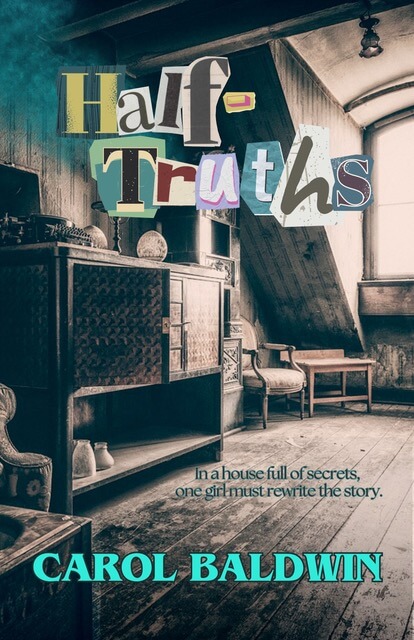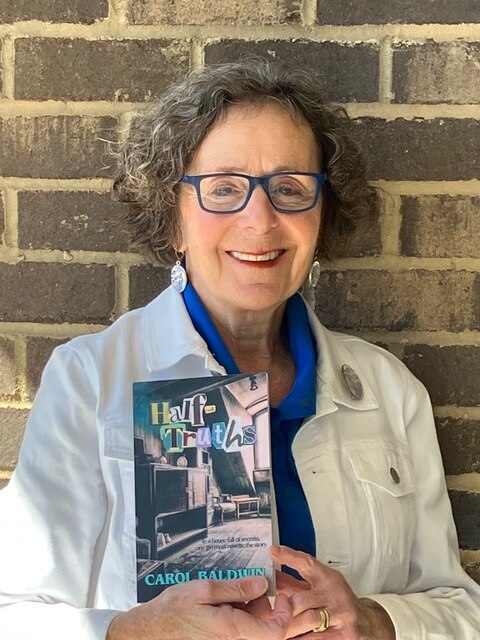I’m so excited to be talking today with Carol Baldwin about her new clean YA historical fiction book, Half-Truths.

Half-Truths is set in 1950, and 15-year-old Kate Dinsmore wants to become a journalist. But, her tobacco-farming father can’t afford to send her to college. She devises a plan to move from rural North Carolina to her wealthy grandparents’ home in Charlotte in hopes of gaining their financial support. There she meets Lillian, her grandmother’s teenage maid, and, in spite of their racial differences, they form a tentative friendship. While exploring her grandmother’s attic, Kate unearths a secret that rocks her world and Lillian’s too. The shocking discovery reveals half-truths that threaten the girls’ friendship. What will Kate do when she must choose between Lillian and her new society friends?
Big Books, Little Ears: Carol, I’m so excited for your new historical fiction chapter book for teens! What type of reader will love this YA fiction book, Half-Truths?
Carol: I think readers who love historical fiction, multi-generational stories, books that depict the ups and downs of friendships, interesting family dynamics, and social justice will enjoy the story.
Half-Truths isn’t a faith market YA chapter book, but it has a lot of Christian themes. Can you tell us about those, and how they drive the story?
First, as you can imagine from the title, being truthful is important to the story. The book takes place in Charlotte, NC in 1950. My protagonist, Kate Dinsmore, is White, and the most important secondary character, Lillian Bridges, is Black. In the story, they discover that they are related. To preserve the veneer of acceptability, the family buried an incriminating secret about Kate’s great-grandfather. In the process of uncovering the truth, Kate comes to grips with her half-truths. Paul’s admonition to “Speak the truth in love” (Ephesians 4:15) isn’t quoted in the novel, but I hope readers will find it in this coming-of-age story.
Second, there are many Biblical principles relating to social justice. Paul also instructed that there is neither “Jew nor Gentile, slave or free, male or female” (Galatians 3:28). Kate refers to that principle of equality in Chapter Two when she reads a KKK flyer. Her friendship with Lillian helps root out some misbeliefs embedded in her life about race.
The third and overarching theme is one of reconciliation. As Christians, we know that the most important step to mend our broken relationships is to confess our sins to the Lord and one another. Forgiveness, healing, trust, and intimacy can’t happen without humble acknowledgment of our wrongdoing. In the “all is lost” moment, Kate says a half-truth about Lillian which hurts Lillian deeply. Kate must own that behavior for the two of them to be reconciled (James 5: 16). This is also a story about racial reconciliation.
What would a parent want to know about the content of this YA historical fiction before their child reads it? Is there any romance in Half Truths?
There is no romance in the book. But as I’ve indicated, there is an adulterous relationship between Kate’s great-grandfather and his slave, Lillian’s great-grandmother. It is not graphically portrayed, but the reader will see that a child (Lillian’s grandmother) is born out of wedlock. Some readers interpret this as rape. I leave that up to the reader to decide.
I know your publisher is a “clean” publisher, but clean means different things to different people. What does “clean YA book” mean to you?
The Lord opened the doors to Monarch Educational Services and I’m proud to be a part of their publishing house.
This is their mission statement: “Our mission is to provide high-quality, uplifting stories that align with a wholesome worldview, ensuring that readers of all ages have access to clean, enriching, and thought-provoking books that encourage growth, wonder, and wisdom.”
I agree with the publisher, Jen Lowry, that her books have no sexual content, do not condone the abuse of drugs and alcohol, and have no profanity. She diligently includes content ratings such as the following ones for Half-Truths, so that parents know the content before they purchase the book.
Half-Truths contains themes that reflect the realities of the time period, including:
- Racial discrimination and segregation – Includes historically accurate language and
depictions of segregation. - The Ku Klux Klan (KKK) and racial violence – References to the KKK’s presence,
intimidation, and racial injustice. - Historical language – The terms colored and Negro are used within the story to
maintain historical accuracy. - Themes of prejudice and injustice – Explores societal norms and the impact of racism
in the 1950s. - Mention of a slave having a child by a slave owner – This is an integral part of the
generational trauma explored in the book.
This book is written with sensitivity and historical accuracy, aiming to encourage critical thinking, empathy, and discussions about past and present social issues.
Recommended for ages 13 and up.
Something I tell people regularly is that YA is a genre, not a reading level. With that in mind, what reading level is Half-Truths written at? Would it be a good option for advanced readers who are reading above grade level, or perhaps for students reading below grade level, looking for more mature stories?
I agree with your definition of YA! I believe readers from 13 and up will enjoy the book. Because of the back story, it would be up to a parent’s discretion to allow a younger, advanced reader to read it. I hope that mothers, grandmothers, and daughters will read Half-Truths and talk about the family relationships and time period.
Where can readers find you and your book?
You can find Half-Truths on Amazon.
People can also connect with me through my linktree. (There’s a link there for signed copies form my local independent book store.)

Is there anything else you would like my readers to know?
If you’re in a book club or homeschool group and decide to read Half-Truths, contact me and I’ll host a Q&A discussion online for your group!


